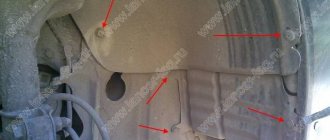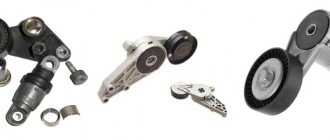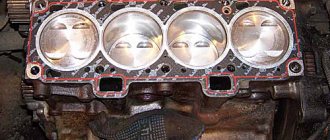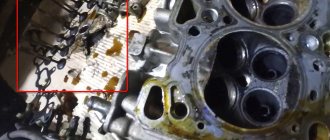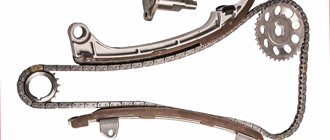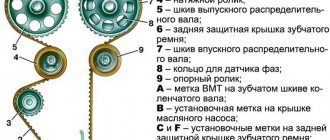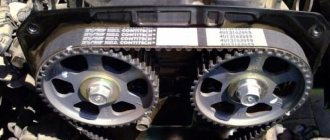Maintaining the appropriate voltage in the vehicle's on-board network during operation of the power plant rests with one of the elements of the vehicle's electrical equipment - the generator. A generator is the same DC electric motor that works in reverse. If the engine rotates the rotor due to the supply of electricity to it, then the generator generates electricity from the rotational movement of the rotor. In order for the generator to generate energy that will power the vehicle's on-board network, its rotor must rotate.
A design solution for ensuring rotation of the generator rotor, as a result of which it generates electricity, was the drive from the crankshaft, since it rotates constantly from the moment the engine starts until it stops.
The generator is driven by a belt drive. Pulleys are installed on the crankshaft and generator rotor, in the grooves of which the belt is placed.
Types of alternator belts
Two types of belts are used to drive the generator.
- The first type of drive belt is a regular V-belt. Often this type of belt is used on cars that were produced earlier. These belts are used on cars where the drive from the crankshaft pulley was carried out only by the generator. The disadvantage of this product is the high probability of slipping.
Alternator V-belt
One of the variants of the V-belt, which replaced the usual one, is the toothed one. The timing belt also has a V-shaped profile, but it has teeth on the inside. These teeth provide improved power transmission and less slippage. However, it is also used on cars in which the drive from the crankshaft pulley is carried out only by the generator.
Tooth type generator belt
- The second type of drive belt, which is increasingly used on cars, is a poly-V belt, also known as a multi-ribbed belt. This type of belt is much wider than a V-belt, but thinner, which provides it with greater flexibility. Several grooves were made on the inside, the profile resembling a wedge, but small in size. Because of these grooves, this belt received the popular name - multi-groove.
Alternator serpentine belt
High flexibility allows it to be used to drive a generator, as well as other attached engine elements - hydraulic booster, liquid pump and compressor.
All types of belts are made according to the same principle - the main material is special rubber, inside which 2-4 layers of strong reinforcing thread are placed.
Let's sum it up
Taking into account the above information, it becomes clear how to change the alternator belt with your own hands. Moreover, the replacement itself does not require specialized tools or professional skills. In fact, even an ordinary car owner can often cope with such a task. The only caveat is to provide free access to the mechanism for adjusting the tension. On some cars this may be difficult.
Finally, we note that many owners prefer to change timing belts, alternator belts, pulleys and rollers not only for the sake of savings, but because properly performed independent maintenance guarantees the installation of high-quality spare parts and the accurate implementation of all adjustments. As a result, the replaced elements last a long time, and during operation there is often no extraneous noise, etc.
Main problems with the alternator belt
Since the generator drive belt is flexible, the main problems with it are breakage, severe wear, delamination and sagging.
Belt breakage rarely occurs, since significant force is required for the reinforcing threads to break. It can only occur when one of the elements driven by the belt becomes jammed. For example, due to the destruction of a generator bearing, the rotor may jam, followed by a burst.
Severe wear occurs over time, because the surfaces of the belt rub against the surfaces of the pulleys when transmitting force. As a result, the belt profile decreases, it slips more and more, its transmission force drops and the generator stops producing the required energy.
Broken car alternator belt
Delamination is often caused by damage to the pulleys. Violation of the pulley geometry leads to the fact that on one side the belt wears out intensively, the reinforced thread extends beyond the edges of the rubber material, as a result, the belt is gradually divided into its component parts. Delamination can also occur due to poor quality materials.
Car alternator belt delamination
Subsidence also occurs over time due to wear and tear. As the belt wears out, its diameter increases, its tension weakens and slipping occurs. Also, subsidence can be caused by poor quality materials. The contact of fuels and lubricants on the surface of the belt often leads to a change in the physical parameters of the rubber, which can also cause it to sag.
The main sign of problems with the alternator drive belt is the appearance of third-party noise, in particular squeaks and high-pitched squeals. Squealing is usually caused by the belt slipping against the pulley, which is often caused by severe wear or sagging.
In a car where a tension roller is used for tensioning, the appearance of a squeal may indicate, in addition to belt wear, severe wear of the roller bearing.
A short squeal from the belt in winter indicates poor quality material. At subzero temperatures, such a belt significantly loses its elasticity, which leads to intense wear until it warms up. Such a belt will not last long.
What does the damage cause?
A break is often accompanied by a bang from under the hood. A sensor with a battery icon lights up on the dashboard, indicating that the battery has stopped charging. The malfunction leads to power steering failure, which makes the steering wheel difficult to turn. Another sign of a breakdown is a non-working air conditioner. The main problem is that in many cars, one belt drives not only the generator, but also the pump. Due to a break, the coolant stops circulating, which means the engine may overheat. Therefore, if such a problem occurs, you need to turn off the engine and call a technician to replace the alternator belt on site.
Checking status
On average, the belt resource is 50-60 thousand km. But the duration of its operation largely depends on the operating conditions and the quality of the product.
Determining the condition and level of belt wear depends on the design features of the car. But this definition comes down to a visual inspection of the belt.
First, the belt tension is checked. In normal condition, it should not sag when pressed at a certain distance specified in the technical documentation for the car.
Alternator belt layout
Next, the belt is visually inspected for damage and wear. Protruding reinforcing threads, torn pieces of rubber, traces of fuel and lubricants will indicate the need for replacement.
The squealing can be eliminated by additionally tightening the tension. However, if there is nowhere to tighten the belt, it means it is very worn and requires replacement.
If it is determined that the belt is severely worn, it is replaced. Before performing this operation, you need to purchase a new one. Moreover, you need to select according to the car model, as well as the type of belt. It will be impossible to install a V-belt in place of a multi-ribbed one and vice versa.
How to replace a car's alternator belt with your own hands
Replacing the alternator belt is entirely within the capabilities of car enthusiasts who are just beginning to learn the basics of car repair with their own hands.
After all, every car enthusiast tries to save money on the operation and maintenance of his car. There is only one way to do this, if you repair the car yourself. But, with rare exceptions, it is not always possible to change one or another part in a car yourself, and such a rare exception is the alternator belt.
This is a fairly important element of the car; sooner or later every car enthusiast will have to change it, and there is nothing complicated in such a replacement, so let’s look at how you can replace the alternator belt yourself. This knowledge is also useful because the alternator belt can break at the most unpredictable moment, far from a car service center.
In what cases does the alternator belt require replacement?
Replacing the alternator belt may be necessary in three cases: if it is clearly broken, during a scheduled replacement, and if belt defects are detected.
In the first two cases, everything is clear, we cannot avoid replacing the belt, but if during inspection you find that the generator belt has cuts and abrasions, then it is also better to replace it.
How to replace the alternator belt with your own hands
1. Before you start replacing the alternator belt, make room in the hood for this type of work, since in some car models it will not be enough to open the hood and stock up on a wrench to replace the belt. After all, it is much more convenient to change the belt from below the car and to do this you need to lift the front of the car and remove the crankcase protection from the engine.
2. After nothing interferes with removing the belt, look carefully at how the belt is installed. The thing is that the alternator belt often drives not only the alternator, but also other components of the car, so attaching it can be quite complicated.
Therefore, remember, or better yet, take a piece of paper and a pencil, and draw a diagram of how the belt is installed, after which you can begin to remove it. If the car has an alternator belt, then there is also a clamping bolt that gives tension to the belt. This bolt must be loosened and you will be able to remove the belt.
3. Compare the removed belt with the belt that you are going to install, they should be identical, there are many examples of how in auto stores, sellers sold alternator belts of a completely different modification than what was needed. If everything is fine with the new belt, install it according to the diagram you previously sketched.
4. Some people wonder what will happen if the alternator belt is installed incorrectly? The most common mistake in this case is that the belt is given either excessive or insufficient tension. If this happens, the belt will not fully perform its functions, and over-tensioning the belt will cause increased wear on the generator bearings.
The tension of the alternator belt must be done according to the tension level that is suitable for your car brand, and all the necessary dimensions are indicated in the car instructions. I recommend approximately checking the generator belt tension as follows:
- you need to press it with your finger in the middle and as a result of this the belt should not bend more than 0.5 cm;
- and the new one is 0.2 cm, if this is not the case, then it should be tightened.
And the most correct way to check the performance of a newly installed alternator belt is to put a load on the instruments in the car, i.e. turn on the headlights, heater and press on the gas.
If a whistle appears, then tighten the belt more, and if there is no characteristic whistle, then everything is in order.
How to replace the alternator belt - video:
As you can see, there is nothing complicated in such repairs. Good luck!
Replacement with VAZ-2108
Let's look at how replacement is done on different cars. To begin with, let's take a VAZ-2108 car, which uses a simple or toothed V-belt.
The belt on this car is quite easy to replace. You only need a 17 key and a pry bar.
First you need to remove the used belt, for which you loosen the fastening nut at the bottom and the nut that clamps the generator to the tensioner. After loosening, the generator is supplied to the engine, and the greatly loosened belt is removed from the pulleys. A new one is installed in its place; the generator is pulled away from the engine with a pry bar, thereby tensioning the belt. While holding the tension with a pry bar, the nut on the tensioner is tightened. Then the generator mounting nut is tightened. After replacement, a check is performed. If no extraneous sounds are heard from the belt when the engine is running, the replacement has been completed successfully. If a squeal occurs, re-tensioning is performed.
Replacement for Toyota Camry
Next, let's look at how replacement is carried out on a Toyota Camry. This car uses a poly V-belt. It is also used to drive a compressor and a liquid pump. A special tensioner is used for tensioning.
If you carry out the replacement according to all the rules, you will need to remove the right wheel, lining and engine crankcase protection to access the tensioner.
But some amateurs make the replacement without removing the wheel. To replace the belt itself, you do not need to unscrew anything, since the tensioner is equipped with a self-tensioning mechanism.
To remove the belt, use a 19mm wrench to hold the head located on the tensioner and turn it clockwise. This action releases the tension, after which the belt is removed from any pulley.
Before installing a new one, you should look at the diagram of the position of the belt between the pulleys. To install it, first put it on all the pulleys, then press the tensioner and put the belt on its roller, after which the tensioner is released.
Belt replacement
First of all, to replace the belt, you need to determine the type of tension roller installed. The Lade has mechanical tension rollers, you need to tension them yourself (you will need a special key for this). While on foreign cars they install rollers with automatic tension.
Replacement on a foreign car:
- Using a suitable wrench, turn the roller counterclockwise; it will be difficult to turn because of the spring, which tends to turn the roller back.
- Remove the old belt from all pulleys. (Remember the order in which it is installed on all pulleys; for example, you can sketch a diagram on a piece of paper)
- Install a new belt and release the roller. As a result, the spring itself will adjust the desired tension.
Replacement for VAZ:
- Loosen the generator mounting bolts at the top and bottom.
- Unscrew the adjusting bolt to the maximum
- Remove the old belt and put on a new one
- By tightening the adjusting bolt, adjust the belt tension.

